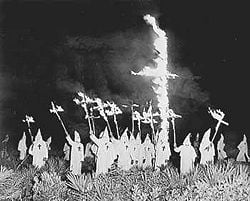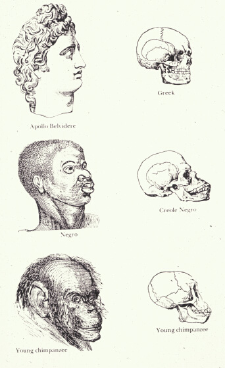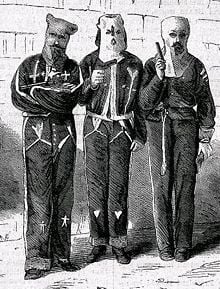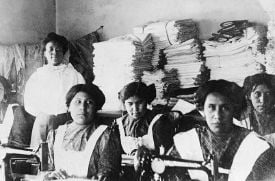
Racism refers to various beliefs maintaining that the essential value of an individual can be determined according to a perceived or ascribed racial category and that social discrimination by race is therefore justifiable. Racial prejudice often includes the belief that people of different races differ in aptitudes and abilities, such as intelligence, physical prowess, or virtue. Most individuals who subscribe to racial categories believe that different races can be placed on a ranked, hierarchical scale. Racism has gone through a process of increasing occurrence and severity as people of different races encountered each other; from discriminatory attitudes, to genocide, to the establishment of social structures institutionalizing racial segregation.
Finally, in the era of globalized society, racism is now officially condemned by international bodies such as the United Nations and the European Union, as well as by numerous states. Thus, the idea of racism has reached the point where it is considered unacceptable, and the idea that we are one human family has taken root.
Definition
Racism is defined as the predication of decisions and policies on considerations of race for the purpose of subordinating a racial group and maintaining control over that group. Organizations and institutions that practice racism discriminate against and marginalize a class of people who share a common racial designation. Racism can more narrowly refer to a system of oppression, such as institutional racism, that is based on the idea of one race's superiority over other races. The term "racism" is usually applied to the dominant group in such a society, because that group typically has the means to oppress others. However, "racism" can be equally applied to any individual or group(s), regardless of social status or dominance. By definition, one who practices racism is known as a racist.
Racism can be overt or subtle, and there are two closely related forms: individuals acting against other individuals and one community acting against another. These are called individual and institutional racism, respectively. Individual racism consists of overt acts by individuals, which can directly cause death, injury, or the destruction of property. Institutional racism is often more difficult to identify but no less destructive. It often originates in the operation of established and respected forces in society and, therefore, it may receive less public condemnation than does individual racism.
Racism is to be distinguished from "racialism," which W.E.B. Du Bois argued was the belief that differences between the races exist, be they biological, social, psychological, or in the realm of the soul. He then went on to argue that racism is using this belief to push forward the argument that one's particular race is superior to the others. Therefore, Du Bois separates the conditions of racism from racism itself.
Debates over the origins of racism often suffer from a lack of clarity over the term. Many use the term "racism" to refer to more general phenomena, such as xenophobia (fear of other races) and ethnocentrism. Attempts have been made to clearly distinguish those phenomena from racism as an ideology or from scientific racism, which has little to do with actual xenophobia.
History of racism
Ethnic conflicts
Racism has been conflated with earlier forms of ethnic and national conflict. In most cases, ethno-national conflict conveys a struggle over land and strategic resources. In certain historical examples, ethnicity and nationalism were harnessed to rally combatants in wars between great religious empires (e.g., the Muslim Turks and the Catholic Austro-Hungarians). Notions of race and racism often have played central roles in such ethnic conflicts. Historically, when an adversary was identified as "other," based on notions of race or ethnicity (particularly when "other" is construed as "inferior"), the means employed by the self-presumed "superior" party to appropriate territory, human chattel, or material wealth often have been more ruthless, more brutal, and less constrained by moral or ethical considerations.
During the Valladolid controversy in the middle of the sixteenth century, people like Juan Ginés de Sepúlveda argued that the Native Americans were natural slaves because they had no "souls." In Asia, the Chinese and Japanese Empires were both strong colonial powers, with the Chinese making colonies and vassal states of much of East Asia throughout history and the Japanese Empire doing the same in the nineteenth-twentieth centuries. In both cases, the Asian imperial powers believed they were ethnically and racially superior to their vassals, and entitled to be their masters.

In the Western world, racism evolved, encompassed the doctrine of "white supremacy," and helped fuel the European exploration, conquest, and colonization of much of the rest of the world— especially after Christopher Columbus reached the Americas.
One example of the brutalizing and dehumanizing effects of racism was the attempt to deliberately infect Native Americans with smallpox during Pontiac's Rebellion in 1763, itself a war intended to ethnically cleanse the "other" (Anglo-Americans) from Native American land; each side "othered" the other. According to historian Daniel Richter, Pontiac's Rebellion introduced "the novel idea that all native people were 'Indians,' that all Euro-Americans were 'Whites,' and that all on one side must unite to destroy the other" to both sides of the conflict.[1]
It has also been argued that racism surfaced more recently—as late as the 1800s—due to the need for a justification for slavery in the United States. Maintaining that Africans were "subhuman" was the only loophole in the prevalent ideal that "all men are created equal." Theories about "race" developed, allowing many to justify the differences in position and treatment of people whom they categorized as belonging to different races.[2] Racism did not end with the U.S. Civil War, however. Hate groups such as the Ku Klux Klan formed during reconstruction in an attempt to disenfranchise, threaten, and subordinate African Americans.
European colonialism
Authors such as Hannah Arendt, who wrote The Origins of Totalitarianism in 1951, have pointed out how the racist ideology ("popular racism") that developed at the end of the nineteenth century helped legitimize the imperialist conquests of foreign territories and crimes that ensued (such as the Herero and Namaqua genocide in 1904-1907). French philosopher Auguste Comte's positivist ideology of social progress as a consequence of scientific progress, led many Europeans to believe in the inherent superiority of the "White Race" over non-white races.[3] Rudyard Kipling's poem The White Man's Burden (1899), serves as one of the most famous illustrations of this belief.[4]
Racist ideology thus helped legitimize subjugation, slavery, and the dismantling of the traditional societies of indigenous peoples. Racist rationalizations caused many people to consider such actions humanitarian obligations. Other colonialists recognized the depravity of their actions but persisted for personal gain. Some Europeans objected to the injustices caused by colonialism and lobbied on behalf of aboriginal peoples. Thus, when the so-called "Hottentot Venus" was displayed in England in the beginning of the nineteenth century, the African Association publicly opposed itself to the shameful exhibition. Moreover, the same year that Kipling published his poem, Joseph Conrad published Heart of Darkness (1899), a clear criticism of the Congo Free State owned by Leopold II of Belgium.
Human "zoos" bolstered popular racism by connecting it to scientific racism: people of different races were both objects of public curiosity and of anthropology and anthropometry.[5] Joice Heth, an African-American slave, was displayed by P. T. Barnum in 1836, a few years after the exhibition of Saartjie Bartman, the "Hottentot Venus." Such exhibitions became common in the New Imperialism period and remained so until World War II. Congolese pygmy, Ota Benga, was displayed in 1906 by eugenicist Madison Grant, head of the Bronx Zoo, as an attempt to illustrate the "missing link" between human beings and the orangutan. Thus, racism became linked with Darwinism, creating the ideology of social Darwinism, which tried to ground itself in Darwin's scientific discoveries.
Slavery in the United States
Contention over the morality and legality of the institution of slavery was one of the cardinal issues which led to the U.S. Civil War. The failed attempt at secession by the Confederacy of the United States led to the Emancipation Proclamation, which was the official end of legal slavery in the United States.
Emancipated African Americans in the United States still had to struggle against institutional racism, forced segregation, violation of voting rights, and even terrorism. The Ku Klux Klan (KKK)—perhaps the most notorious racist organization—formed shortly after emancipation. The KKK espouses racist ideologies and enforces discriminatory cultural norms with murderous violence, or the threat thereof.
Fascism
The fascist regimes, which rose to power in Europe (particularly Germany and Italy) and Japan before World War II, advocated and implemented racist, xenophobic, and often genocidal policies and attitudes. While racism, xenophobia, and genocide were not new, the scope of the atrocities committed by the German Nazis and the Japanese Imperialists was without precedent.
Anti-Semitism
Anti-Semitism is a specific case of racism targeting the Jewish people, although scholars argue whether it should be considered a sui generis species or not. For example, in the Russian Empire, official segregation of the Russian Jews in the Pale of Settlement since the early 1800s was compounded by the 1882 May Laws. Waves of anti-Semitic pogroms (riots against a particular group), in many cases state-sponsored, proliferated from 1881-1884, 1902-1906, and 1914-1921. The term "anti-Semitism" is deceptive because "Semitic" peoples technically include both the Arabs and the Hebrews, but "anti-Semitism" only refers to the latter.
Scholars distinguish traditional, Christian anti-Semitism, which derives from the Biblical account of deicide (literally meaning "God-killing" referring to the execution of Jesus by crucifixion), with racial anti-Semitism, which ultimately led to the Holocaust. The State of Israel was established in 1948, when many Jews and Gentiles considered the creation of a Jewish nation-state (which was the aim of Zionism) the only way of acquiring real protection from possible future genocides. At the Second Vatican Council in 1965, the Roman Catholic Church cleared the Jews from allegations of deicide.
Types of racism
Racism may be expressed individually, through explicit and implicit thoughts, feelings, or acts, or socially, through institutions that promote inequalities among "races," as in institutional racism. Scientific racism is the use of scientific arguments to support belief in differences among races.
Scientific racism

Scientific racism refers to the use of science (or the veneer of science) to justify and support racist beliefs. The concept goes back at least to the early eighteenth century, though it gained most of its influence in the mid-nineteenth century. Works like Gobineau's An Essay on the Inequality of the Human Races (1853-1855) attempted to frame racism within the terms of biological difference among human beings. After the work of Charles Darwin became well-known, the rise of theories of evolution led many to consider some races more "evolved" than others. These points of view became very common within the scientific community at the time—even Darwin, who was an active abolitionist and considered all humans to be of the same species (against a trend of polygenism popular in anthropology at the time), believed that there were inherent biological differences in the mental capacities of different races. Ideologies such as social Darwinism and eugenics used and reinforced many of these views.
Some scientists argued against biological reinforcement of racism, even if they believed that biological races existed. In the fields of anthropology and biology, however, these were minority positions until the mid-twentieth century. During the rise of Nazism in Germany, many scientists in Western nations worked to debunk the racial theory on which the regime rested its claims of superiority. This, combined with repulsion to Nazi eugenics and the racial motivations behind the Holocaust, lead to a reorientation of opinion around scientific research on race in the years following World War II. Changes within scientific disciplines—such as the rise of Boasian school of anthropology in the United States—also contributed to this shift. Many of the scientific studies which claimed to support racist claims have since been methodologically debunked by scientists with specifically anti-racist agendas, such as Stephen Jay Gould.
Individual racism
Examples of individual racism include an employer not hiring a person, failing to promote, giving harsher duties, imposing harsher working conditions, or firing an employee, in whole or in part due to his race. Individual racism can take any of the following forms:
- Racial prejudice is pre-formed personal opinions about individuals on the basis of race. (e.g., John thinks that Mary will have bad attribute X solely because Mary is a member of race Y.)
- Racial discrimination is different treatment of people on the basis of characteristics which may be classified as racial—including skin color, cultural heritage, and religion. (e.g., Mary refuses to hire John because he is of race Y.) This is a concept not unanimously agreed upon. While this usually refers to discrimination against minority racial groups in Western societies, it can also refer to the opposite situation. This form of discrimination is often called reverse discrimination when it is due to affirmative action or other attempts to remedy past or current discrimination against minority racial groups.
- Cultural racial discrimination occurs when members of one culture build the assumption of inferiority of one or more races into their culturally-maintained image of those races. (e.g., Members of group X are taught to believe that they are members of a superior race, and, consequently, they consider members of other races inferior.)
- Same-race racism occurs when members of one race associate behaviors or appearances of other members of their race as being related to negative features of another race. Some darker-skinned African Americans dislike lighter-skinned African Americans because of their lighter shade of skin, which may or may not be associated with white parentage at some point in their genealogy. A form of cultural racism (see above) can also be related to this, where members of a racial group are chastised by members of their own group for co-opting a culture which is perceived to be associated with another race. (e.g., A stigma against "acting white" exists in some African-American communities.)
- Reverse racism is a pejorative and controversial term used to describe attitudes, behaviors, and policies which are racially discriminatory in a manner contrary (i.e. reverse) to historical patterns of racial discrimination.
Institutional racism
Structural or institutional racism involves social structures that promote racism. Examples of these types of structures include:
- Affirmative action is the practice of favoring or benefiting members of a racial minority in areas such as college admissions and workplace advancement, in an attempt to counter-balance what are perceived as systemic biases towards the racial majority. Though presented as an effort to ensure equal opportunity, opponents of racial quotas in jobs and schools contend that explicitly factoring race into the application or approval process is a form of institutionalized reverse racism which unfairly discriminates against racial categories with historically higher admission or approval rates. Proponents contend that racial quotas promote integration and economic equality of groups which have been affected by racism.
- Historical, economic, or social disparity is a form of discrimination caused by past racism. Deficits in the formal education and other kinds of preparation in the parents' generation, and racist attitudes and actions of members of the general population affect the present generation of a certain race. (e.g., A member of Race Y, Mary, has her opportunities adversely affected (directly and/or indirectly) by the mistreatment of her ancestors of race Y.)
- Racialism is a term often found within white separatist literature, referring to a social emphasis on racial origin. Racism implies an assumption of racial superiority and harmful intent, whereas separatists sometimes prefer the term "racialism," indicating a strong interest in matters of race without necessarily assuming superiority or a desire to harm others. Rather, they focus on racial segregation and "white pride." That said, most English dictionaries and most people make no sharp distinction between "racism" and "racialism." African American sociologist W.E.B. Du Bois argued that racialism is the belief that differences between the races exist, be they biological, social, psychological, or in the realm of the soul. He defined racism as using a belief in racial differences to push forward the argument that one's particular race is superior to the others.
- Global apartheid is a phrase used by those who argue that the international economic, social, and political system is racist and is designed so that a white minority accrues more wealth and power and enjoys more human and legal rights internationally than the non-white world majority.
Examples of Institutional racism
See also: Jim Crow Laws
Racial discrimination is and has been official government policy in several countries. The racial policy of Nazi Germany is the most famous example, along with Apartheid in South Africa.
In the United States, Native Americans were considered an inferior race, to be "civilized" or else relegated to "reservations." After the end of slavery following the Civil War, Separate but equal became the legal form of racial segregation. In the twentieth century, racial profiling of minorities by law enforcement officials became a controversial subject. Law enforcement looks for people who "fit the profile" to commit a crime according to experience and statistics. Some people consider this to be a form of racism.
Racial policy of Nazi Germany
The Racial Policy of Nazi Germany refers to the policies and laws implemented by Nazi Germany, asserting the superiority of the Aryan race, and including measures aimed primarily against Jews.
The origins of the policy lay with the Dolchstoßlegende ("betrayal legend"), whereby disgruntled German nationalists blamed non-Germans for the loss of World War I. The Nazis exploited those sentiments and later developed them into the "Nuremberg laws," which employed a pseudo-scientific basis for racial discrimination against Jews: People with four German grandparents were of "German blood," while people were classified as Jews if they descended from three or more Jewish grandparents. Having one or more Jewish grandparents made someone "mixed blood." In the absence of discernible external differences, the Nazis used the religious observance of a person's grandparents to determine their "race."
Though the laws were primarily directed against Jews, other "non-Aryan" people were subject to these laws and to other legislation concerned with "racial hygiene." At least 400 mixed-race children were forcibly sterilized, while others were sent to concentration camps. Mixed marriages remained illegal throughout the Nazi's reign.
Apartheid in South Africa
Apartheid (literally "apartness" in Afrikaans and Dutch) was a system of racial segregation enforced in South Africa from 1948 to 1991. Under apartheid, people were legally classified into a racial group—most people fell under one of four classifications: White, Black, Indian, and Colored—and were geographically and forcibly separated from each other on the basis of this legal classification. The Black majority, in particular, legally became citizens of particular "homelands" that were nominally sovereign nations but operated more akin to United States "Indian Reservations" and Canadian "Aboriginal Reserves." In reality, a majority of Black South Africans had never resided in these "homelands" prior to 1948.
By law, the four racial groups were capitalized. The Colored group included people of mixed Bantu, Khoisan, and European descent (with some Malay ancestry, especially in the Western Cape). The Apartheid bureaucracy devised complex (and often arbitrary) criteria upon the implementation of the Population Registration Act to determine who belonged to the Colored group. Minor officials would administer tests to determine if someone should be categorized Colored or Black, or Colored or White. Different members of the same family found themselves in different racial groups. Further tests determined membership of the various sub-racial groups of the Coloreds.
Apartheid was implemented by the law. The following restrictions were not only adopted socially but were strictly enforced by law (the Reservation of Separate Amenities Act specifically allowed the government to provide different levels of amenities for the different races):
- Non-white people were not allowed to run businesses or professional practices in areas designated as "white South Africa" without a permit. Instead, they had to move to the black homelands and set up businesses and practices there.
- Transportation and civil facilities were segregated.
- Black people were excluded from living or working in white areas unless they had a pass. Only black people with "Section 10" rights (those who had migrated to the cities before World War II) were exempt from this provision. White people required passes in "black" areas.
In practice, this prevented non-white people—even those who lived in white South Africa—from having a vote or any influence, restricting their rights to the confines of faraway homelands which they may never have had the opportunity to visit. Education, medical care, and other public services were sometimes identified as "separate but equal," but those available to non-white people were in fact vastly inferior. The government prohibited sex and marriage between the races.
Apartheid pervaded South African culture and law. The media reinforced the perception of non-white South Africans as second-class citizens, and the lack of opportunities for the races to mix in a social setting entrenched social distance between people.
Many of the inequalities created and maintained by apartheid still remain in South Africa. In 2004, the country had one of the most unequal income distribution patterns in the world: Poverty in South Africa is still largely defined by skin color, with black people making up around 90 percent of the country's poor .[6]
Native Americans in the United States
Native Americans in the United States (also known as Indians, American Indians, Amerindians, Amerinds, or Indigenous, Aboriginal or Original peoples or Americans) are the indigenous peoples and their descendants within the territory that is now encompassed by the continental United States and parts of Alaska.
From the fifteenth to the nineteenth century, the European colonization of the Americas decimated the population of the Native Americans through displacement, disease, warfare, and enslavement.
In the nineteenth century, the incessant Westward expansion of the United States incrementally compelled large numbers of Native Americans to resettle further west—sometimes by force and almost always reluctantly. Under President Andrew Jackson, Congress passed the Indian Removal Act of 1830, which authorized the President to conduct treaties to exchange Native American land east of the Mississippi River for lands west of the river. As many as 100,000 Native Americans eventually relocated to the West as a result of this Indian Removal policy. In theory, relocation was supposed to be voluntary (and many Native Americans did remain in the East), but in practice great pressure was put on Native American leaders to sign removal treaties. Arguably the most egregious violation of the stated intention of the removal policy was the Treaty of New Echota, which was signed by a dissident faction of Cherokees but not by the elected leadership. President Martin Van Buren's brutal enforcement of the treaty resulted in the deaths of an estimated 4,000 Cherokees (mostly from disease) on the "Trail of Tears."
American policy toward Native Americans has been an evolving process. In the late nineteenth century, reformers, in efforts to "civilize" Indians, adapted the practice of educating native children in Indian Boarding Schools. These schools, which were primarily run by Christians, proved traumatic to Native American children, who were forbidden to speak their native languages, taught Christianity instead of their native religions, and in other ways forced to abandon their various Native American identities and adopt European-American culture. There are also many documented cases of sexual, physical, and mental abuses occurring at these schools.[7]
The Indian Citizenship Act of 1924 gave United States citizenship to Native Americans, in part because of an interest by many to see them merged with the American mainstream, and also because of the heroic service of many Native American veterans in World War I.
Separate but equal: African Americans after Reconstruction
After the American Civil War (1861–1865) brought about the end of slavery, Plessy v. Ferguson (1896) became the de facto standard throughout the U.S. Southern states and represented the institionalization of the segregation period. In theory, African Americans and European Americans received the same services (schools, hospitals, water fountains, bathrooms, etc.), but each "race" had a distinct facility. In practice, the services and facilities reserved for African Americans were frequently of lower quality than those reserved for white people; for example, many African-American schools received less public funding per student than nearby white schools. The legitimacy of such laws was upheld by the U.S. Supreme Court in the Plessy case.
Attorneys for the NAACP employed the phrase "Separate but equal" during the Supreme Court litigation of Brown v. Board of Education (1954). It referred to the phrase "equal but separate" used in Plessy v. Ferguson (1896) as a custom of de jure racial segregation enacted into law. The repeal of "separate but equal" laws was a key focus of the civil rights movement of the 1950s and 1960s. In Brown v. Board of Education (1954), the Supreme Court outlawed segregated public education facilities for black and white people at the state level; the companion case of Bolling v. Sharpe outlawed such practices at the Federal level in the District of Columbia.
Racism in the twenty-first century
Since the last quarter of the twentieth century, "racism" has become a pejorative term, and identification of a group or person as "racist" is almost always controversial. A number of international treaties have sought to end racism. The United Nations uses a definition of "racial discrimination" laid out in the International Convention on the Elimination of All Forms of Racial Discrimination and adopted in 1966:
any distinction, exclusion, restriction or preference based on race, color, descent, or national or ethnic origin which has the purpose or effect of nullifying or impairing the recognition, enjoyment or exercise, on an equal footing, of human rights and fundamental freedoms in the political, economic, social, cultural or any other field of public life.[8]
The European Union, following up with a positive course of action following the 1997 "Year against Discrimination," condemns multiple factors for discrimination, not the least of which is race:
Article 21 of the charter prohibits discrimination on any ground such as sex, race, color, ethnic or social origin, genetic features, language, religion or belief, political or any other opinion, membership of a national minority, property, birth, disability, age or sexual orientation and also discrimination on the grounds of nationality.[9]
Thus, as human society moved into the new millennium, racism was recognized as unacceptable, and efforts have been increased to end its practice once and for all.
Notes
- ↑ Daniel K. Richter. Facing East from Indian Country: A Native History of Early America (Cambridge, MA: Harvard University Press, 2003, ISBN 0674011171), 208.
- ↑ Eric R. Wolf, Europe and the People without History (University of California Press, 1982, ISBN 0520048989).
- ↑ Auguste Comte, Cours de Philosophie Positive (6 volumes), published 1830-1842; translated into English 1853.
- ↑ Rudyard Kipling 'The White Man's Burden' and US Imperialism GlobalPolicy.org, November, 2003. Retrieved June 16, 2020.
- ↑ Pascal Blanchard, Sandrine Lemaire and Nicolas Bancel, Human zoos - Racist theme parks for Europe's colonialists Le Monde Diplomatique, August 2000. Retrieved June 16, 2020.
- ↑ United Nations report highlights growing inequality in South Africa World Socialist Web Site, May 21, 2004. Retrieved June 16, 2020.
- ↑ Andrea Smith, Soul Wound: The Legacy of Native American Schools Amnesty International Magazine, October 9, 2015. Retrieved June 16, 2020.
- ↑ International Convention on the Elimination of All Forms of Racial Discrimination United Nations Office of the High Commissioner. Retrieved June 16, 2020.
- ↑ Article 21 - Non-discrimination EU Charter of Fundamental Rights. Retrieved June 16, 2020.
ReferencesISBN links support NWE through referral fees
- Barkan, Elazar. The retreat of scientific racism: changing concepts of race in Britain and the United States between the world wars. New York: Cambridge University Press, 1992. ISBN 978-0521458757
- Bauer, Yehuda. A History Of The Holocaust. New York: F. Watts, 1982. ISBN 0531098621.
- Dain, Bruce. A hideous monster of the mind: American race theory in the early republic. Cambridge, MA: Harvard University Press, 2002. ISBN 0674009460
- Friedländer, Saul. Nazi Germany and the Jews Volume 1 The Years of Persecution, 1933-1939. New York: HarperCollins, 1997. ISBN 0060190426
- Kipling, Rudyard. Kipling’s Verse: Definitive Edition. New York: Doubleday, 1940.
- Lévi-Strauss, Claude. Race and History. Franklin Classics, 2018. ISBN 978-0343291396
- Peukert, Detler and R. Deveson (Translator). Inside Nazi Germany: conformity, opposition and racism in everyday life. London: Penguin Books Ltd, 1989. ISBN 978-0140228458
- Richter, Daniel K. Facing East from Indian Country: A Native History of Early America, New Ed. Cambridge, MA: Harvard Univ. Press, 2003. ISBN 0674011171
- Rocchio, Vincent F. Reel Racism. Confronting Hollywood's Construction of Afro-American Culture. Westview Press, 2000. ISBN 0813367107
- Taguieff, Pierre-André. La Force du préjugé. Essai sur le racisme et ses doubles. Tel Gallimard, La Découverte, 1987. ISBN 2070719774
- Wolf, Eric R. Europe and the People without History. Berkeley: University of California Press, 1982. ISBN 0520048989
External links
All links retrieved December 7, 2022.
- Race: The Power of an Illusion, an in-depth website presenting the argument that while race is a biological fiction, racism permeates the structure of society.
- George W. Gill argues here for the biological concept of "race" and, in a matching article, C. Loring Brace argues against the existence of "race" as a biological entity Nova Online.
- Racism from Global Issues
- Institute of Race Relations
- Racism Anti-Defamation League.
Credits
New World Encyclopedia writers and editors rewrote and completed the Wikipedia article in accordance with New World Encyclopedia standards. This article abides by terms of the Creative Commons CC-by-sa 3.0 License (CC-by-sa), which may be used and disseminated with proper attribution. Credit is due under the terms of this license that can reference both the New World Encyclopedia contributors and the selfless volunteer contributors of the Wikimedia Foundation. To cite this article click here for a list of acceptable citing formats.The history of earlier contributions by wikipedians is accessible to researchers here:
- Racism history
- History_of_South_Africa_in_the_apartheid_era history
- Racial_policy_of_Nazi_Germany history
- Native_Americans_in_the_United_States history
- Separate_but_equal history
The history of this article since it was imported to New World Encyclopedia:
Note: Some restrictions may apply to use of individual images which are separately licensed.



